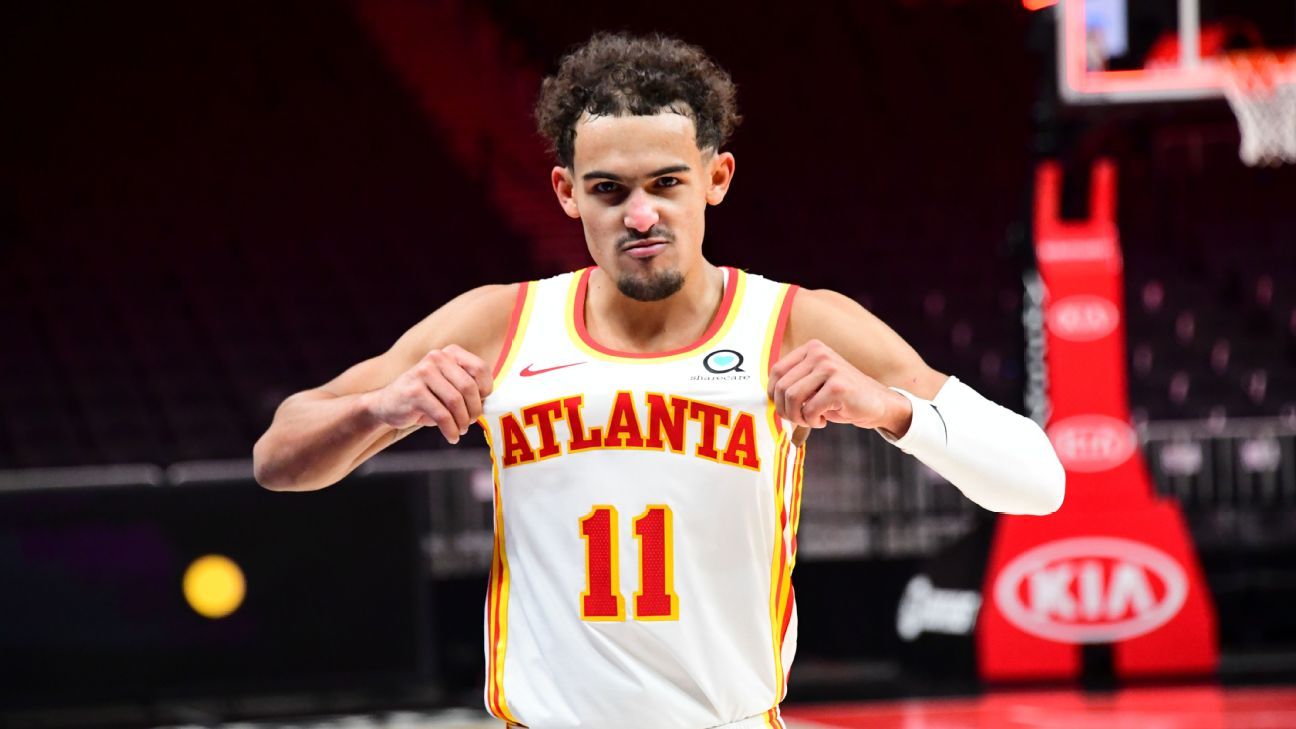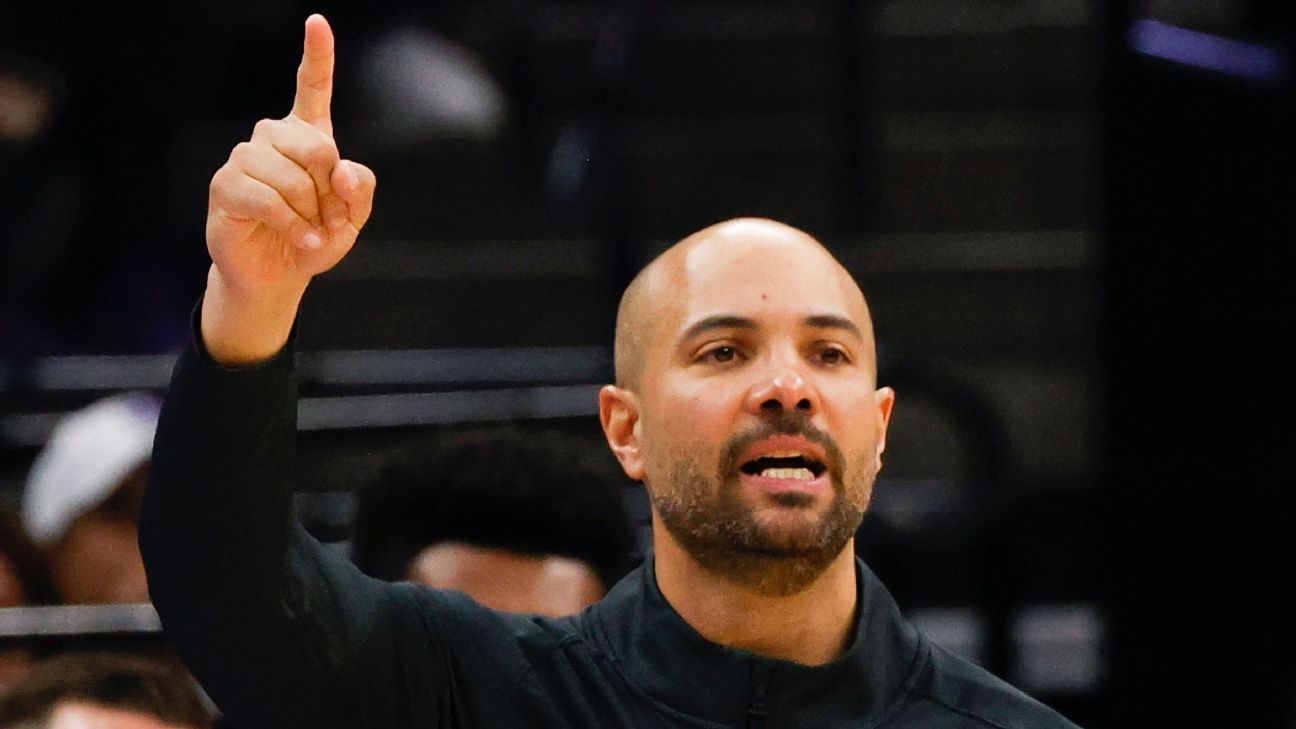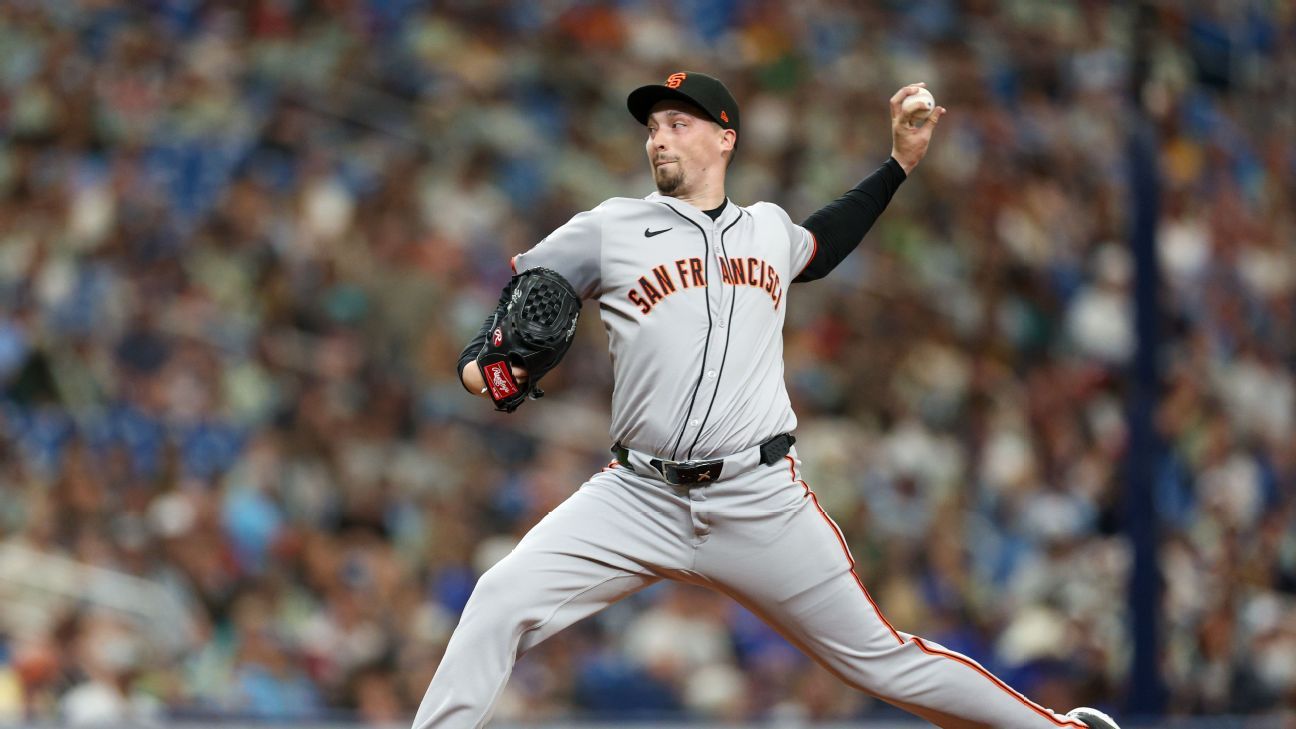
ONE OF TRAE YOUNG'S favorite moves is simple. He gets the ball, calls for a screen and turns the corner, putting his defender on his hip as the help comes over to corral the drive. Once he feels his defender behind, he brake-checks, pulling up into a quick shot.
A little old thing called Newton's first law of motion kicks in: A body in motion remains in motion unless acted upon by a force, i.e. the defender runs helplessly into Young's back.
The whistle blows. The foul is called. Two free throws are given.
Young hit the Brooklyn Nets with the move on Dec. 30. Nets head coach Steve Nash was not a fan.
"That's not basketball!" Nash yelled at the officials.
Nash's criticism went viral, and Young and the Hawks defended the star guard's tactic while others debated and discussed its fairness.
"I learned a lot about drawing fouls from [Nash]," Young told reporters in early January. "If he says it's not basketball, he must've been saying it about himself because he's done it a couple of times throughout his career and was so successful."
Trae Young leaves Nets incensed with his brake-check move
Trae Young continually gets to the free throw line against the Nets by stopping short and causing a defender to run into him.
For his part, Nash said he was just sticking up for his team and trying to gain an edge with the refs. It was a heat-of-competition comment, but he has no real issue with Young's play. Players have constantly been searching for advantages within the game: inventing and reinventing different ways to bend the rules.
"Other guys have pet moves that are there to deceive or to fool not just the defense, but the referees," Nash said. "That's where the game continues to evolve."
Moves like Young's stop-short jumper are crafted, refined and mastered through years of innovation. And like a cartoon rowboat, the league plugs one hole only to find another.
The prevailing feeling around the league: If you're not pushing the boundaries, you're not trying.
MONTY MCCUTCHEN HAD never seen such trickery.
Ben Gordon, an undersized shooting guard that spent time with the Chicago Bulls, Detroit Pistons, Charlotte Bobcats and Orlando Magic, was dribbling at the top of the key.
Gordon, a right-handed shooter, brought his left hand toward the ball as if he was preparing to gather, rise and take a jumper. But right before the ball hit his left hand, Gordon put the ball back down on the floor as his defender went flying. It was a pump-fake without the pump. (Today, players like Stephen Curry and Kemba Walker have mastered the move, too.)
"I almost blew the whistle," said McCutchen, a 24-year veteran referee who now works as the NBA's vice president of referee development and training. "I went up to Ben during the game and said, 'You almost not only fooled [the defender] but you almost fooled me.'
"He goes, 'I know, I've been working on that move.'"
McCutchen is well aware of the schemes players pull. It was routine before games that players would approach him to pitch a sneaky move they'd been workshopping in the lab and ask whether it was legal.
Referees watch tape. They know what kind of offenses teams run, if they play on the low block or spread the floor. They also pick up on players' tricks. But there's balance involved in not predisposing oneself to player tendencies. "You can't let that knowledge turn into anticipation [that] leads to a quick decision," McCutchen said.
"They're not annoying. If you watch enough games every night, you know what to expect. There's a skill to that. That stuff James [Harden] does where he puts the ball out, that's a skill. DeMar DeRozan is great at it. That's a skill." Suns guard Chris Paul
Like every front office and coach, referees are well aware of the surging impact of analytics. Efficiency drives the game, and that means plenty of corner 3s, shots at the rim, and, of course, free throws. In the same way coaches design offenses to create the most efficient shots, players try to find ways to the stripe.
If deceiving an official is the best path, so be it.
"There's all these concepts that are very clinical in the rulebook," McCutchen said. "Our teams and our players then push that limit of what the rulebook says, until we as the league say we like or don't like how our game is right now."
Plays like Young's brake-check jumper have created a lot of conversation within the league. But there are so many clever maneuvers players use. Some are so subtle to the point of being nearly unnoticeable, like Kyle Lowry setting up to take a charge and gently pulling the offensive player into him to make it look like he got plowed over.
McCutchen has a polite name for these players: innovators. He won't name names, though NBA fans know who the prime culprits and the strategies they deploy.
"Innovators, such as some of the players you may be imagining," McCutchen said, "are always going to test the rules."
A good example: The rulebook is clear about two steps after a gather. But what it doesn't say is that the steps have to be forward, backward or sideways. Players like James Harden, Jayson Tatum and others have, ahem, innovated to take that step-back to extremes.
McCutchen recalled Boston Celtics great Paul Pierce splitting double teams, jumping from one foot to the same foot, then taking a second step with his other foot. At the time, it technically wasn't a travel. The league's competition committee amended the rule: no hopping.
"Referees and the league are always going to be a half-step or step behind our teams and players," McCutchen said. "Because their job is to find the advantage. That's how you win, is finding little advantages that over 48 minutes add up to seven points or three points or one point."
Separating players from their reputations is part of the referee's job. It might seem that there could be some prejudice for the players that routinely make officials look bad, or lower their grade for getting more calls wrong. But officiating those players is a challenge to embrace.
"That's the challenge of a referee that you let the outside noise of status run to the side, and you don't worry about the status, you worry about the actual rule," McCutchen said. "You start to take on the mentality that it's about the concept."
"Now," McCutchen said with a grin, "some players are better than others at maximizing the concept."
CHRIS PAUL IS a true basketball genius. He plays in the game in a perpetual state of bullet time, with plays going by in slow motion. Details and intricacies are seamlessly picked up on the fly.
And Paul, who has served as players' union president since 2013, isn't bashful about talking about the rules of the game -- even bending them. If he sees a defender hanging his leg out, Paul will run into contact and force a whistle.
A cousin to Young's brake-check pull-up is Paul's stop-short, where a ball handler will feel a defender on their back, typically in the backcourt, 50 or more feet from the basket, and slam on the brakes to let an unassuming defender run over them for a foul. To some, that's simply known as "the Chris Paul."
Once an opposing team puts the Phoenix Suns in the bonus, there isn't a more dangerous player on the floor.
Another favorite of Paul's is the rip-through, a tactic seemingly popularized by Kevin Durant in 2009. It's simple: Your defender is on you with an arm outstretched. You swing the ball in a counterclockwise motion (if you're right-handed) into the defender's unassuming arms, catching contact as you begin something resembling a shooting motion.
CP3 uses the rip-through move to draw a foul
Chris Paul uses his patented 'rip-through move' to draw a foul.
As a young player, Durant struggled with defenders crowding him and needed something to counter their aggressiveness. He was taught the move by teammate Desmond Mason.
"Desmond warned me that guys were going to get up into me on defense," Durant said in 2010. "I saw him do it a few times and I kind of stole it from him."
Coaches and opposing players constantly complained about it before, during and after games. Durant didn't care. It was free points any time a defender had a mental lapse.
"They've said it's a legal play, so I'm going to keep doing it until they tell me I can't," Durant said after a game in March 2011. "That's when I'll stop."
Now, players like Philadelphia 76ers big man Joel Embiid are picking up the move from watching Durant. But it's a technique that goes back decades, used by Kobe Bryant in the NBA Finals in 2008 and Tim Duncan before that. Like Young's pull-up, Paul said he remembers Chauncey Billups doing the rip-through some 20 years ago.
Until 2011, this was a shooting foul, but the league legislated against it, turning it into a foul on the floor. Like he said he'd do, Durant stopped using it nearly as much. (He did hit the Washington Wizards with it in January in a critical spot late in the game.)
Paul, though, as he does, found a gray area to continue to expose the rule: just wait until his team is in the bonus. It's still a foul, just not a shooting foul. So late in quarters, Paul will deploy the rip-through and get two free throws. You can see the exasperation on the faces of defenders the moment Paul gets them.
"Like, 'Damn, why does this dude do this stupid s---?'" Suns forward Abdel Nader said when asked what goes through his mind when opponents pull off a successful rip-through. "Other than that, you've gotta keep playing, move on."
In surveying players around the league, the rip-through was by far the most popular answer for biggest pet peeve move.
"That's what great scorer's do though, they know the rules and know how the refs call it and they get fouls drawn," Oklahoma City Thunder forward Mike Muscala said. "It doesn't seem like a natural basketball play."
Paul said he hears assistant coaches screaming at defenders to be ready for it, to get their hands back. Milwaukee Bucks guard Donte DiVincenzo was a recent victim, and as coaches yelled at him to be aware, DiVicenzo said, "What?"
"By the time he heard it," Paul said, "it was too late."
If there's a player that seeks those advantages within the rules of the game McCutchen talked about, it's The Point God.
"They're not annoying. If you watch enough games every night, you know what to expect. There's a skill to that," Paul countered. "That stuff James [Harden] does where he puts the ball out, that's a skill. DeMar DeRozan is great at it. That's a skill."
IT IS IMPOSSIBLE to say who invented the pump fake. Basketball footage as far back as the 1950s will show players pump-faking defenders and driving past them. They use all sorts of dekes and counters and hesitations.
But one innovation started teetering into clever/annoying territory -- the pump-and-jump. You pump-fake your defender to get them to leave their feet, then use their groundless situation against them to jump into them for a foul call. Pierce was good at it. Dwyane Wade mastered it. Walt Frazier did it as far back as 1973.
The pump-and-jump is one of the eye-rolliest plays in the game, but to an official, it's more straightforward than it appears. It's the more subtle ones, like an offensive player throwing their head back to draw attention to contact, or a big man disguising a moving screen as roll to the basket, or a big man giving a slight nudge to clear space.
"It's called the Black Tornado," Shaquille O'Neal said of his savvy veteran and very legal move. "Bump, spin, bump, get you off balance and then dunk in your face. Just to let you know that you ain't strong enough and you ain't ready."
The league gathers feedback every season on player moves and tactics. The competition committee looks at them and will sometimes legislate changes. Because at the core, the league wants to make sure the game stays beautiful, can flow and not get driven down by gray-area maneuvers. Still: It's almost impossible for the league to stay ahead of the players.
There are plays like Reggie Miller's scissorkick, where he'd cleverly leave one leg hanging out on a jumper for a defender to potentially clip. It was irritating, and in 2012, seven years after Miller retired the league implemented, you guessed it, "The Reggie Miller Rule," that made it an offensive foul to leave a leg out.
By next season, we might be talking about "The Trae Young Rule." But until the league legislates it out of the game, it's fair play. And it's up to the players to discover counters.
There are extreme measures, like in 2018 when LeBron James picked Paul up about 40 feet from the bucket.
LeBron was shading Paul on his right hip, as Paul dragged the ball around near the floor. LeBron, who does his homework, knew Paul was in position to deploy the rip-through. So LeBron put his hands behind his back.
Patty Mills guarded Harden for basically an entire playoff series this way. Because there's not much you can do to counter these clever plays. A foul is a foul and the referee has to call it. Some are embellished, like when Harden or Paul, or any player takes a bit of awkward-looking contact and falls to the floor, forcing a whistle.
Harden is an offensive craftsman and has perfected the art of drawing fouls. He'll do little things, like calling for a screen and waiting for the on-ball defender to glance over his shoulder to see where the screen is coming from and then drag his arms into the defender's outstretched arms.
Is it cheap? Most players and coaches say definitely. Is it a foul? Also yes.
Before a recent matchup with Nikola Jokic, Suns center Deandre Ayton pored over film of Jokic's favorite moves and foul-drawing tactics. Because as Ayton said, all he can do is be prepared.
"Whatever my matchup is, whoever I'm playing against, I look at their tendencies, what's their bread and butter. I counter it and I learn from it," Ayton said. "That's something I'm good at is watching my matchup and knowing what he loves to do. ...
"We want you to make a mistake. I'll defend you until you make one."
The other thing to try, Ayton said: Get in front of it. Talk to the ref before the game and tell them to be on the lookout for these cheeky plays.
"In the post, I'll tell the refs, when I know it's a center that likes to bang, like Jokic, I'll tell the ref, 'Hey, just watch my hands,'" Ayton said. "Showing my hands when I'm taking contact, so don't call a foul. Just reminding the ref, 'Yo, we bangin' but my hands aren't in there, I'm straight up.'"
With every savvy play, there are two perspectives. If it's in your favor, it's a good thing. If not, it's cheap.
That's how Nash felt about Young's savvy move in the heat of the moment. And, like former Thunder center Steven Adams said last season when asked about Paul's favorite:
"Oh, it's great. [When] he's on my team."
ESPN's Marc Raimondi contributed to this story.














 Phone: (800) 737. 6040
Phone: (800) 737. 6040 Fax: (800) 825 5558
Fax: (800) 825 5558 Website:
Website:  Email:
Email: 






